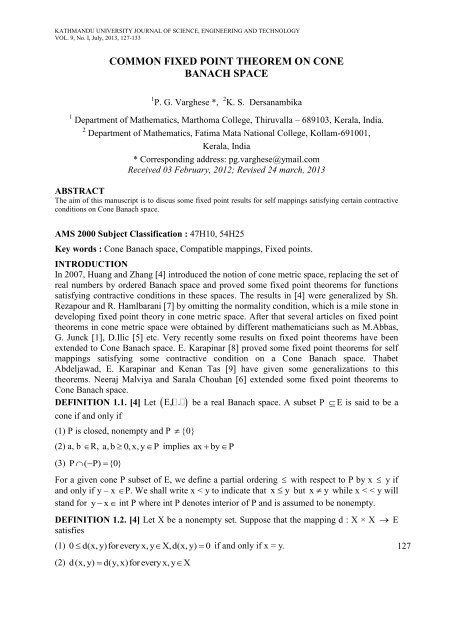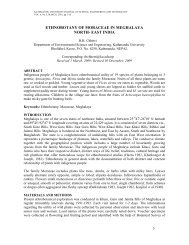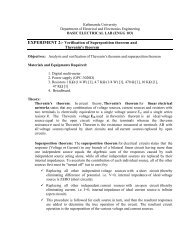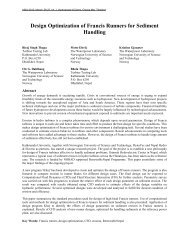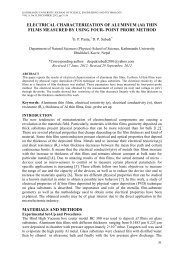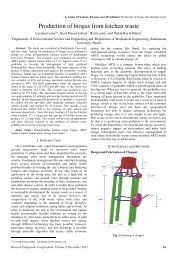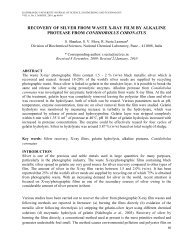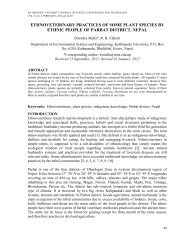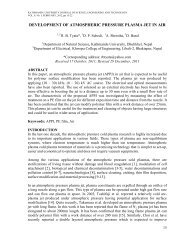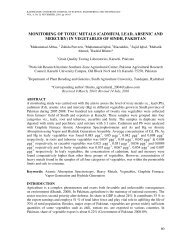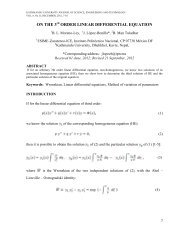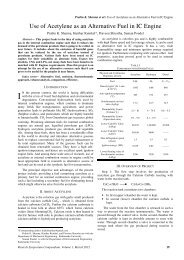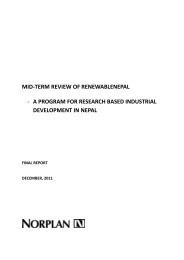common fixed point theorem on cone banach space - Kathmandu ...
common fixed point theorem on cone banach space - Kathmandu ...
common fixed point theorem on cone banach space - Kathmandu ...
Create successful ePaper yourself
Turn your PDF publications into a flip-book with our unique Google optimized e-Paper software.
KATHMANDU UNIVERSITY JOURNAL OF SCIENCE, ENGINEERING AND TECHNOLOGYVOL. 9, No. I, July, 2013, 127-133COMMON FIXED POINT THEOREM ON CONEBANACH SPACE1 P. G. Varghese *, 2 K. S. Dersanambika1 Department of Mathematics, Marthoma College, Thiruvalla – 689103, Kerala, India.2 Department of Mathematics, Fatima Mata Nati<strong>on</strong>al College, Kollam-691001,Kerala, India* Corresp<strong>on</strong>ding address: pg.varghese@ymail.comReceived 03 February, 2012; Revised 24 march, 2013ABSTRACTThe aim of this manuscript is to discus some <str<strong>on</strong>g>fixed</str<strong>on</strong>g> <str<strong>on</strong>g>point</str<strong>on</strong>g> results for self mappings satisfying certain c<strong>on</strong>tractivec<strong>on</strong>diti<strong>on</strong>s <strong>on</strong> C<strong>on</strong>e Banach <strong>space</strong>.AMS 2000 Subject Classificati<strong>on</strong> : 47H10, 54H25Key words : C<strong>on</strong>e Banach <strong>space</strong>, Compatible mappings, Fixed <str<strong>on</strong>g>point</str<strong>on</strong>g>s.INTRODUCTIONIn 2007, Huang and Zhang [4] introduced the noti<strong>on</strong> of c<strong>on</strong>e metric <strong>space</strong>, replacing the set ofreal numbers by ordered Banach <strong>space</strong> and proved some <str<strong>on</strong>g>fixed</str<strong>on</strong>g> <str<strong>on</strong>g>point</str<strong>on</strong>g> <str<strong>on</strong>g>theorem</str<strong>on</strong>g>s for functi<strong>on</strong>ssatisfying c<strong>on</strong>tractive c<strong>on</strong>diti<strong>on</strong>s in these <strong>space</strong>s. The results in [4] were generalized by Sh.Rezapour and R. Hamlbarani [7] by omitting the normality c<strong>on</strong>diti<strong>on</strong>, which is a mile st<strong>on</strong>e indeveloping <str<strong>on</strong>g>fixed</str<strong>on</strong>g> <str<strong>on</strong>g>point</str<strong>on</strong>g> theory in c<strong>on</strong>e metric <strong>space</strong>. After that several articles <strong>on</strong> <str<strong>on</strong>g>fixed</str<strong>on</strong>g> <str<strong>on</strong>g>point</str<strong>on</strong>g><str<strong>on</strong>g>theorem</str<strong>on</strong>g>s in c<strong>on</strong>e metric <strong>space</strong> were obtained by different mathematicians such as M.Abbas,G. Junck [1], D.Ilic [5] etc. Very recently some results <strong>on</strong> <str<strong>on</strong>g>fixed</str<strong>on</strong>g> <str<strong>on</strong>g>point</str<strong>on</strong>g> <str<strong>on</strong>g>theorem</str<strong>on</strong>g>s have beenextended to C<strong>on</strong>e Banach <strong>space</strong>. E. Karapinar [8] proved some <str<strong>on</strong>g>fixed</str<strong>on</strong>g> <str<strong>on</strong>g>point</str<strong>on</strong>g> <str<strong>on</strong>g>theorem</str<strong>on</strong>g>s for selfmappings satisfying some c<strong>on</strong>tractive c<strong>on</strong>diti<strong>on</strong> <strong>on</strong> a C<strong>on</strong>e Banach <strong>space</strong>. ThabetAbdeljawad, E. Karapinar and Kenan Tas [9] have given some generalizati<strong>on</strong>s to this<str<strong>on</strong>g>theorem</str<strong>on</strong>g>s. Neeraj Malviya and Sarala Chouhan [6] extended some <str<strong>on</strong>g>fixed</str<strong>on</strong>g> <str<strong>on</strong>g>point</str<strong>on</strong>g> <str<strong>on</strong>g>theorem</str<strong>on</strong>g>s toC<strong>on</strong>e Banach <strong>space</strong>.DEFINITION 1.1. [4] Let E, . be a real Banach <strong>space</strong>. A subset P E is said to be ac<strong>on</strong>e if and <strong>on</strong>ly if(1) P is closed, n<strong>on</strong>empty and P {0}(2) a, b R, a,b 0,x, y P implies ax byP(3) P ( P) {0}For a given c<strong>on</strong>e P subset of E, we define a partial ordering with respect to P by x y ifand <strong>on</strong>ly if y – x P. We shall write x < y to indicate that x y but x y while x < < y willstand for yx int P where int P denotes interior of P and is assumed to be n<strong>on</strong>empty.DEFINITION 1.2. [4] Let X be a n<strong>on</strong>empty set. Suppose that the mapping d : X × X Esatisfies(1) 0 d(x, y)foreveryx, yX,d(x, y) 0 if and <strong>on</strong>ly if x = y.(2) d(x, y) d(y,x)foreveryx, yX127
KATHMANDU UNIVERSITY JOURNAL OF SCIENCE, ENGINEERING AND TECHNOLOGYVOL. 9, No. I, July, 2013, 127-133(3) d(x, y) d(x,z) d(z, y)foreveryx, y,zXThen d is a c<strong>on</strong>e metric <strong>on</strong> X and (X, d) is a c<strong>on</strong>e metric <strong>space</strong>.DEFINITION 1.3. [8] Let X be a vector <strong>space</strong> over R. Suppose the mapping . : X Esatisfies(1) x 0for allx X(2) x 0if and<strong>on</strong>lyif x 0(3) x y x y forallx, yX(4) kx | k | x forallk RThen ||. || is called a norm <strong>on</strong> X, and X, . is called a c<strong>on</strong>e normed <strong>space</strong>. Clearly eachc<strong>on</strong>e normed <strong>space</strong> if a c<strong>on</strong>e metric <strong>space</strong> with metric defined by d (x, y) = x y .DEFINITION 1.4. [8] Let X, . be a c<strong>on</strong>e normed <strong>space</strong>, x X and {x n } a sequence inX. Then(1) {x n } c<strong>on</strong>verges to x if for every c E with o
KATHMANDU UNIVERSITY JOURNAL OF SCIENCE, ENGINEERING AND TECHNOLOGYVOL. 9, No. I, July, 2013, 127-133where a + b + c + 2d + e [0, 1), x, y, X. If the range of g c<strong>on</strong>tains the range of f, g(X) iscomplete, f; g are c<strong>on</strong>tinuous and compatible. Then f and g have a unique <str<strong>on</strong>g>comm<strong>on</strong></str<strong>on</strong>g> <str<strong>on</strong>g>fixed</str<strong>on</strong>g><str<strong>on</strong>g>point</str<strong>on</strong>g>.PROOF : Let x0 X, since f (x0) f (X) g(X) there is x 1 X such that f (x 0 ) = g(x 1 ). Lety 1 = f(x 0 ) = g(x 1 ). Now x1 X, since f x1f (X) g(X) there is an x 2 such thatf(x 1 ) = g(x 2 ). Let y2 f (x1) g(x2)c<strong>on</strong>tinuing like this we get a sequence {y n } in X suchy f (x ) g(x ),n 0,1,2........thatn n1 nWe shall prove|| y y || || y y ||n n1 n1 n2Where < 1. We have|| yn yn1|| = || g(xn1) g(xn) ||=nn1|| f (x ) f (x ) ||a || g(x ) g(x ) || b || f (x ) g(x ) ||n n1 n n c || f (xn1)g(x n1) || d || f xn g xn1|| + n1 n=n1 n2 nn1 n1 n2a || y y || b || y y || c || y y ||+nn2 n1 n1d || y y || e || y y ||e|| fx g(x ) ||=n1 n2 nn1 n1 n2a || y y || b || y y || c || y y ||d || y y || e || y y ||n n1 n1 n2(1- b - d) || yn yn1|| (a + c + d) || yn1 yn2||a c d|| yn yn1 || || yn 1 yn2||1b da c dLet , then 11 b dThereforeHence|| y y || || y y || , for every nn n1 n1 n2|| y y || || y y ||n 1n n1 1 0Let n > m|| yn ym|| || yn yn1 || || yn 1 yn2 || ......... || yn1 ym||n1 n2 m ........ || y1y0||129
KATHMANDU UNIVERSITY JOURNAL OF SCIENCE, ENGINEERING AND TECHNOLOGYVOL. 9, No. I, July, 2013, 127-133m|| y1y0||1Let c 0, then there is a 0 such that c N (0) PSince 1, for 0 there is a positive integer N such thatmHence || y1y 0|| N (0). So1(2) where N (0) y :|| y || m || y1 y0|| N(0).1 .m|| y1 y0|| for mN.1mmTherefore c || y1 y0|| c N(0) P . This implies || y1y 0|| c.11Therefore (2) becomes || yn y m|| c for n, m N. Hence {y n } is a Cauchy sequence ing(X). But g(X) is complete therefore there is an z g(X) such thatlim y lim f (x ) lim g(x ) z.n n n n n n12Since f and g are c<strong>on</strong>tinuous lim f (x ) f (z),lim fg(x ) f (z)n n .nNow we shall prove f(z) = g(z). We have2 = || f (x ) fg(x ) ||2|| f (xn) gf (xn) ||nnn= g(z), lim n gf (xn) g(z),2limng (xn)a ||gf (x ) g (x ) || b || f (x ) gf (x ) || 2 2n n n nLetting n . We getc ||fg(x ) g (x ) || d || f (x ) g (x ) || e ||fg(xn) gf (xn) ||2 2 2n n n n|| f (z) g(z) || b ||f(z) g(z) || c|| f(z) g(z) || +(1 b c d e) || f(z) g(z) || 0d ||f(z) g(z) || e|| f(z) g(z) ||But (1- b – c – d - e) > 0. Therefore || f (z) g(z) || 0 which implies f(z) = g(z). Hence z is a<str<strong>on</strong>g>point</str<strong>on</strong>g> of coincidence of f and g. To prove uniqueness if possible z 1 is another <str<strong>on</strong>g>point</str<strong>on</strong>g> ofcoincidence of f and g. Then y 1 = f(z 1 ) = g(z 1 ).Now|| f (z) f (z1) || a || g(z) g(z 1) || b || f (z) g(z) || (1- a – d - e) || f(z) – f(z 1 )|| 0c || f (z1) g(z 1) || d || f (z) g(z1) || + e || f (z1) g(z) ||= a || f (z) f (z1) || d || f (z) f (z1) || e || f (z1) f (z) ||But (1 - a - d - e) > 0. Hence f (z) = f (z 1 ). So f (z) = g(z) = f(z 1 ) = g(z 1 ), the uniqueness of z.Since f and g are compatible by definiti<strong>on</strong> 2.5, f and g have a unique <str<strong>on</strong>g>comm<strong>on</strong></str<strong>on</strong>g> <str<strong>on</strong>g>fixed</str<strong>on</strong>g> <str<strong>on</strong>g>point</str<strong>on</strong>g>.130THEOREM 2.2 Let f, g, h, l be mappings <strong>on</strong> C<strong>on</strong>e Banach <strong>space</strong> X,||.|| into itself, with||x|| = d(x, 0) satisfying the c<strong>on</strong>diti<strong>on</strong>s.
KATHMANDU UNIVERSITY JOURNAL OF SCIENCE, ENGINEERING AND TECHNOLOGYVOL. 9, No. I, July, 2013, 127-133(1) || hx – ly|| a || fx – hx|| + b ||fx-ly|| + c || gy – ly|| for all x, y X, a, b, c 0,a+2b+c
KATHMANDU UNIVERSITY JOURNAL OF SCIENCE, ENGINEERING AND TECHNOLOGYVOL. 9, No. I, July, 2013, 127-133From (5) and (6) we get|| y y || || y y ||(7)nn n1 1 0For every n. Let n > m|| yn ym|| || ym ym1 || || ym 1 ym2|| ....... || yn1 yn||m m1 n1 ....... || y1y0|| 0, then there is a 0 such that c N (0) P where N(0) {yE :|| y || }.Since 1 there exist a positive integer N such thatm|| y1y 0|| N (0), which implies1(8)m|| y1y0|| for every mN. Hence1m || y1 y0|| N(0).1mmTherefore c || y1 y0|| c N(0) P . This implies || y1y 0|| cfor n, m N.11Hence by (8) || yn y m|| c for every n, m N so by definiti<strong>on</strong> 2.4 {y n } is a Cauchysequence in X. Since X is complete there is an z X such that z. Therefore{f (x2n1)},{g(x 2n)},{h(x 2n 1)},{l(x 2n)}c<strong>on</strong>verges to z. C<strong>on</strong>tinuity of f implies2f (x2n1) f (z). Since h and f commute hf (x2n1) fh(x 2n1) f (z) . We haveyn|| hf (x ) l(x ) ||2n12n2a || f (x2n1) hf (x2n1) || +Letting n we get2b || f (x2n1) l(x 2n) || c || g(x2n) l(x2n) |||| f (z) z || a || f(z) f(z) || b || f(z) z || c || z z ||(1 b) || f (z) z || 0But 1- b > 0 so || f(z) – z || = 0 which implies f(z) = z. Again|| h(z) l(x 2n) || a || f (z) h(z) || || bf (z) l(x 2n) || c || g(x2n) l(x2n) ||Letting n we get|| h(z) z || a || z h(z) || b || z z || c || z z ||(1 a) || h(z) z || 0But 1-a > 0, hence h(z) = z. Since g is <strong>on</strong>to there is u X, such that z = g(u). We have|| hf (x2n1) l(u) Letting n we geta || f (x ) hf (x ) || b || f (x ) l(u) || 2 22n1 2n1 2n1c || g(u) l(u) ||132
KATHMANDU UNIVERSITY JOURNAL OF SCIENCE, ENGINEERING AND TECHNOLOGYVOL. 9, No. I, July, 2013, 127-133|| z l(u) || a || z z || b || z l(u) || c || z l(u) ||(1 b c) || z l(u) || 0Since 1-b-c > 0, this implies z = l(u). Therefore g(u) = l(u) = z. Since g and l commute= lg (u) = gl (u) = g(z). We have|| h(x 2n1l(z) || a || f (x2n1) h(x2n1) || b || f (x2n1) l(z) || c || g(u) l(u) ||Letting n we get|| z l(z) || a || z z || b || z l(z) || c || z l(z) ||(1 b c) || z l(z) || 0But 1- b - c > 0, hence z = l(z). This implies g(z) = l(z) = z. Thereforef (z) = g(z) = h(z) = l(z) = z. Hence z is a <str<strong>on</strong>g>fixed</str<strong>on</strong>g> <str<strong>on</strong>g>point</str<strong>on</strong>g> of f, g, h and l.To prove the uniqueness let z be another <str<strong>on</strong>g>fixed</str<strong>on</strong>g> <str<strong>on</strong>g>point</str<strong>on</strong>g> of f, g, h and l.|| z z || = || h(z) l(z) ||(1-b - c ) || z z || 0 a || f(z) h(z) || b || f(z) l(z ) || c || g(z ) l(z ) ||= a || z z || b || z z || c || z z ||But 1- b - c > 0 thus zz . Therefore f, g, h and l has a unique <str<strong>on</strong>g>comm<strong>on</strong></str<strong>on</strong>g> <str<strong>on</strong>g>fixed</str<strong>on</strong>g> <str<strong>on</strong>g>point</str<strong>on</strong>g>.l(z)REFERENCES[1] Abbas M, Jungck G, Comm<strong>on</strong> <str<strong>on</strong>g>fixed</str<strong>on</strong>g> <str<strong>on</strong>g>point</str<strong>on</strong>g> results for n<strong>on</strong>commuting mappingswithout c<strong>on</strong>tinuity in c<strong>on</strong>e metric <strong>space</strong>, J. Math. Anal. Appl. 341 (2008)416.[2] Deimling K, N<strong>on</strong> linear functi<strong>on</strong>al analysis, Springer- Veriag, (1985).[3] Erdal Karapinar, Fixed <str<strong>on</strong>g>point</str<strong>on</strong>g> Theorems in C<strong>on</strong>e Banach Space, Hindawi PublishingCorporati<strong>on</strong>, Fixed <str<strong>on</strong>g>point</str<strong>on</strong>g> Theory and Applicati<strong>on</strong>s, Article ID 609281, (2009)9.[4] Huang L G , Zhang X, C<strong>on</strong>e metric <strong>space</strong> and <str<strong>on</strong>g>fixed</str<strong>on</strong>g> <str<strong>on</strong>g>point</str<strong>on</strong>g> <str<strong>on</strong>g>theorem</str<strong>on</strong>g>s, Math. Anal. Appl.332 (2) (2007)1468.[5] Ilic D and Rakoevic V, Comm<strong>on</strong> <str<strong>on</strong>g>fixed</str<strong>on</strong>g> <str<strong>on</strong>g>point</str<strong>on</strong>g>s for maps <strong>on</strong> c<strong>on</strong>e metric <strong>space</strong>, J.Math.Anal. Appl. 341 (2) (2008) 876.[6] Kang S M and Rhoades B, Fixed <str<strong>on</strong>g>point</str<strong>on</strong>g>s for four mappings, Math. Jap<strong>on</strong>ica, 37(6)(1992), 1053.[7] Neeraj Malviya and Sarla Chouhan, Proving Fixed <str<strong>on</strong>g>point</str<strong>on</strong>g> Theorems Using GeneralPrinciples in C<strong>on</strong>e Banach Space, Internati<strong>on</strong>al Mathematical Forum, 6(3)(2011)115.[8] Sh. Rezapour, R Hamlbarani, Some notes <strong>on</strong> the paper “C<strong>on</strong>e Metric <strong>space</strong> and Fixed<str<strong>on</strong>g>point</str<strong>on</strong>g> Theorems of c<strong>on</strong>tractive mappings”, J. Math, Anal. Appl. 345 (2008) 719.[9] Thabet Abdeljawad, Erdal Karapinar and Kenan Tas, Comm<strong>on</strong> <str<strong>on</strong>g>fixed</str<strong>on</strong>g> <str<strong>on</strong>g>point</str<strong>on</strong>g> Theoremsin C<strong>on</strong>e Banach <strong>space</strong>s, Hacettpe Journal of Mathematics and Statistics, 40(2) (2011)211.133


